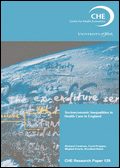 SELECTED FOR YOU... MAY 2016
SELECTED FOR YOU... MAY 2016
 books of the month
books of the month
 watch on health economics
watch on health economics
All the Selected for you
BOOKS
Pharmaceutical Expenditure And Policies. Past Trends And Future Challenges.
Belloni A., Morgan D., Paris V.
Paris : OCDE, 2016/04
Across OECD countries, pharmaceutical spending reached around USD 800 billion in 2013, accounting for about 20% of total health spending on average when pharmaceutical consumption in hospital is added to the purchase of pharmaceutical drugs in the retail sector. This paper looks at recent trends in pharmaceutical spending across OECD countries. It examines the drivers of recent spending trends, highlighting differences across therapeutic classes. While the consumption of medicines continues to increase and to push pharmaceutical spending up, costcontainment policies and patent expiries of a number of top-selling products have exerted downward pressure on pharmaceutical expenditures in recent years. This resulted in a slower pace of growth over the past decade. The paper then looks at emerging challenges for policy makers in the management of pharmaceutical spending. The proliferation of high-cost specialty medicines will be a major driver of health spending growth in the coming years. While some of these medicines bring great benefits to patients, others provide only marginal improvements. This challenges the efficiency of pharmaceutical spending.
Socioeconomic Inequalities in Health Care in England.
Cookson R., Propper C., Asaria M.
York : University of York, 2016/04
This paper reviews what is known about socioeconomic inequalities in health care in England, with particular attention to inequalities relative to need that may be considered unfair (‘inequities'). We call inequalities of 5% or less between most and least deprived socioeconomic quintile groups ‘slight'; inequalities of 6-15% ‘moderate', and inequalities of > 15% ‘substantial'. Overall public health care expenditure is substantially concentrated on poorer people. At any given age, poorer people are more likely to see their family doctor, have a public outpatient appointment, visit accident and emergency, and stay in hospital for publicly funded inpatient treatment. After allowing for current self-assessed health and morbidity, there is slight pro-rich inequity in combined public and private medical specialist visits but not family doctor visits. There are also slight pro-rich inequities in overall indicators of clinical process quality and patient experience from public health care, substantial pro-rich inequalities in bereaved people's experiences of health and social care for recently deceased relatives, and mostly slight but occasionally substantial pro-rich inequities in the use of preventive care (e.g. dental checkups, eye tests, screening and vaccination) and a few specific treatments (e.g. hip and knee replacement). Studies of population health care outcomes (e.g. avoidable emergency hospitalisation) find substantial pro-rich inequality after adjusting for age and sex only. These findings are all consistent with a broad economic framework that sees health care as just one input into the production of health, alongside many other socioeconomically patterned inputs including environmental factors (e.g. living and working conditions), consumption (e.g. diet, smoking), self care (e.g. seeking medical information) and informal care (e.g. support from family and friends).

